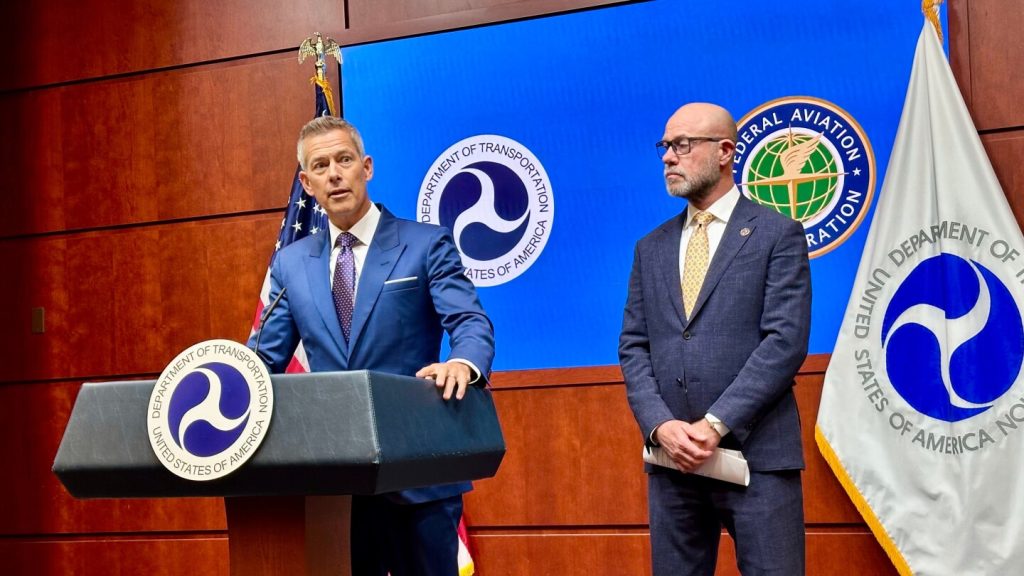Listen to the article
In an unprecedented move, the Federal Aviation Administration announced Wednesday it will reduce air traffic by 10% across 40 “high-volume” markets starting Friday morning, citing growing strain on air traffic controllers who have been working without pay during the government shutdown.
“I’m not aware in my 35-year history in the aviation market where we’ve had a situation where we’re taking these kinds of measures,” FAA Administrator Bryan Bedford said during a news conference.
The decision affects thousands of flights within the FAA’s daily coordination of more than 44,000 commercial passenger, cargo and private aircraft operations. Officials plan to identify affected airports and cities by Thursday after meeting with airline executives.
Air traffic controllers, who have been working unpaid since the shutdown began October 1, are exhibiting signs of fatigue and stress. Many are working mandatory overtime and six-day weeks, while others are calling out due to financial constraints like inability to afford childcare or gas. Some have taken second jobs to make ends meet.
“We’re not going to wait for a safety problem to truly manifest itself when the early indicators are telling us we can take action today to prevent things from deteriorating,” Bedford explained. “The system is extremely safe today and will be extremely safe tomorrow. If the pressures continue to build even after we take these measures, we’ll come back and take additional measures.”
U.S. Transportation Secretary Sean Duffy joined Bedford in emphasizing the proactive nature of the decision, referencing lessons learned from January’s deadly midair collision between a commercial jet and military helicopter near Ronald Reagan Washington National Airport.
“We learned from that. And so now we look at data, and before it would become an issue, we try to assess the pressure and try to make moves before there could be adverse consequences,” Duffy said.
Major airlines including United, Southwest and American have pledged to minimize customer impact as they adjust schedules. In a letter to employees, United CEO Scott Kirby assured that the airline would focus cuts on regional routes rather than long-haul international or hub-to-hub flights.
“That’s important to maintain the integrity of our network, give impacted customers as many options as possible to resume their trip, and sustain our crew pairing systems,” Kirby wrote, adding that the airline would offer refunds to travelers who prefer not to fly during this period, even if their specific flight isn’t canceled.
The cuts could affect as many as 1,800 flights and more than 268,000 seats across the system, according to aviation analytics firm Cirium. As an example, Chicago’s O’Hare International Airport could see 121 of its 1,212 flights scheduled for Friday eliminated if reductions are distributed equally.
Industry analyst Henry Harteveldt, president of Atmosphere Research Group, criticized the government’s approach, suggesting the 48-hour notice given to airlines was insufficient for properly rebuilding schedules. He also speculated the Trump administration might be using aviation safety “to force the two sides in Washington back to the negotiating table to resolve the shutdown.”
Data indicates the situation has been worsening. An Associated Press analysis shows that over the past weekend, at least 39 different air traffic control facilities announced potential limited staffing—significantly higher than pre-shutdown averages. Before October 1, weekend staffing issues affected an average of 8.3 facilities. During the five weekend periods since the shutdown began, that average has more than tripled to 26.2 facilities.
AAA spokesperson Aixa Diaz advised travelers to monitor their airline’s app and airport social media accounts for updates, recommending extra time for airport arrivals. “It’s frustrating for travelers, because there’s not much you can do. At the end of the day, you either fly or you don’t,” she said.
The announcement came just one day after Secretary Duffy warned of potential “chaos in the skies” next week if the shutdown continues long enough for air traffic controllers to miss their second full paychecks, expected next Tuesday.
Major airlines, aviation unions and the broader travel industry have joined in urging Congress to end the shutdown, which became the longest on record early Wednesday.
Fact Checker
Verify the accuracy of this article using The Disinformation Commission analysis and real-time sources.




28 Comments
The cost guidance is better than expected. If they deliver, the stock could rerate.
Good point. Watching costs and grades closely.
Good point. Watching costs and grades closely.
Interesting update on FAA reducing air traffic by 10% across 40 ‘high-volume’ markets during government shutdown. Curious how the grades will trend next quarter.
Good point. Watching costs and grades closely.
Interesting update on FAA reducing air traffic by 10% across 40 ‘high-volume’ markets during government shutdown. Curious how the grades will trend next quarter.
Good point. Watching costs and grades closely.
Uranium names keep pushing higher—supply still tight into 2026.
Good point. Watching costs and grades closely.
Nice to see insider buying—usually a good signal in this space.
Good point. Watching costs and grades closely.
Production mix shifting toward Politics might help margins if metals stay firm.
Nice to see insider buying—usually a good signal in this space.
Good point. Watching costs and grades closely.
Nice to see insider buying—usually a good signal in this space.
Good point. Watching costs and grades closely.
Exploration results look promising, but permitting will be the key risk.
Good point. Watching costs and grades closely.
Good point. Watching costs and grades closely.
Exploration results look promising, but permitting will be the key risk.
Good point. Watching costs and grades closely.
If AISC keeps dropping, this becomes investable for me.
Good point. Watching costs and grades closely.
Good point. Watching costs and grades closely.
Nice to see insider buying—usually a good signal in this space.
The cost guidance is better than expected. If they deliver, the stock could rerate.
Good point. Watching costs and grades closely.
I like the balance sheet here—less leverage than peers.